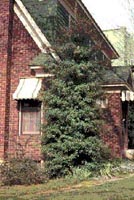Resource Library
Plant of the Week: Holly, Foster
The University of Arkansas System Division of Agriculture does not promote, support or recommend plants featured in "Plant of the Week." Please consult your local Extension office for plants suitable for your region.
Plant of the Week
Foster Holly
Latin: Ilex x attenuata

Great landscape plants have a way of rising to the top in the nursery world. For a
plant to be truly great, it must be one that the nurseryman can grow relatively quickly,
and it must have good landscape characteristics that make it a long-term success in
the landscape.
The Foster holly certainly fits this description.
Foster holly is a chance hybrid that occurred between a narrow-leafed form of the
Dahoon Holly (I. cassine var. angustifolia) as the female parent and American Holly (I. opaca) as the daddy in the union. The trees grow 25 to 30 feet tall with a spread of 6
to 8 feet, giving them a narrow, conical form. The bright evergreen leaves are 2 inches
long and elongated with one to three small, nonthreatening spines on each side of
the leaf margin near the tip.
The typical form seen in gardens is "Foster No. 2," a female clone that produces
an abundance of red, pea-sized fruit even on young plants. The male pollinator of
the Foster set is ‘Foster No. 4,’ but male American hollies will also pollinate the
female "No. 2."
The Foster hollies were selected by E. E. Foster of Foster Nursery, Bessemer, Ala.,
and released in the 1940s. He selected five plants out of his seed beds, giving them
numbers one through five. Foster No. 2 is the most important of the lot.
Walk into a Wal-Mart or any retail garden center today, and you have to watch your
step for fear of tripping over container-grown plants. But this wasn’t always the
case. In the pre-World War II days before container growing -- a California innovation
-- and interstate highways clogged with 18-wheelers, nurserymen were more self-reliant
and most grew a high percentage of the plants they sold.
In today’s cookie-cutter world where conformity seems to be a virtue, we see similar
kinds of plants produced throughout an entire region because they are being grown
by the large nurseries that fill the supply pipeline. All aspiring nurserymen -- or
curious gardeners for that matter -- should maintain an area where they can grow some
seedlings just in case they find one of those gems in the rough that will ensure horticultural
immortality.
Foster holly is an excellent plant for planting near an entry or off the corner of
the house to provide vertical accent. Like most plants with this strikingly conical
form, it can be grown as a free-standing specimen or massed together. It also makes
an excellent tall screen or can be sheared into a hedge. If used in mass plantings,
the length of the mass should be at least one and a half times longer than the plants
will be allowed to grow tall to create visual harmony.
Like most hollies, Foster holly does best in a reasonably good garden soil where
it can receive some water during dry periods. The soil pH should be on the acid side.
While best in full sun, it will do well in medium shade.
Foster holly can be sheared as needed to keep it full or left to its own devices.
If plants ever get too large, they can be stubbed back severely in the spring just
before new growth starts and will regrow quickly to a compact but smaller size.
By: Gerald Klingaman, retired
Extension Horticulturist - Ornamentals
Extension News - November 24, 2000
The University of Arkansas System Division of Agriculture does not maintain lists of retail outlets where these plants can be purchased. Please check your local nursery or other retail outlets to ask about the availability of these plants for your growing area.